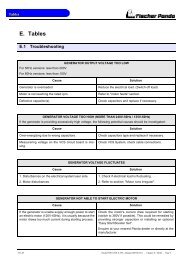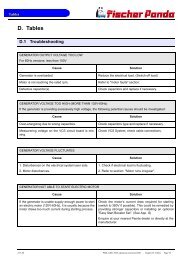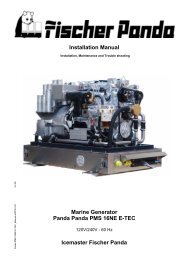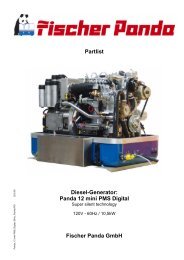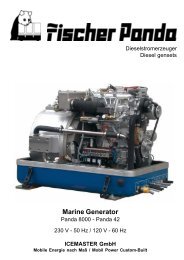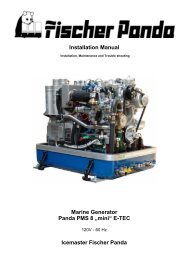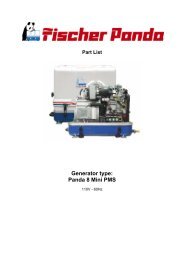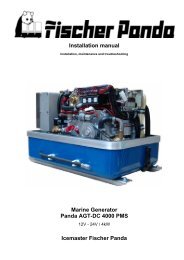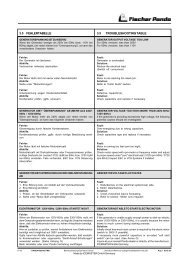Manual
Manual
Manual
Create successful ePaper yourself
Turn your PDF publications into a flip-book with our unique Google optimized e-Paper software.
Generator Failure<br />
at full load.<br />
The Panda is designed so as not to overheat even under extreme conditions. Note: The exhaust gas will become<br />
sooty during peak-load operation.<br />
7.3.1 Effects of Short Circuiting and Overloading on the Generator<br />
The generator cannot be damaged by short circuiting or overloading. Short circuiting and overloading suppress the<br />
magnetic excitation of the generator, thus, no current is generated and the voltage will collapse. This condition is<br />
immediately offset once the short-circuit has been eliminated and/or the electrical overload removed.<br />
7.3.2 Overloading the Generator with Electric Motors<br />
Please note that electric motors require six to ten times more power than their rated capacity to start.<br />
If the supplied generator power is lower than what the electric motor requires, the generator voltage will collapse. For<br />
applications where a high current draw is required to start an electrical device (such as an electric motor), the motor<br />
manufacturer should be consulted for possible solutions (for example: stronger capacitors, gradual power-up switches,<br />
or a specially designed starting unit for electric motors).<br />
System efficiency can be improved by up to 50% and motor current draw (to start) reduced by as much as 100% if it<br />
is properly designed. If the inductive load (i.e. E-Motor) is more than 20% of the generator nominal power, a compensation<br />
is necessary. See also the information brochure „Special information for operation of Panda generators<br />
with inductive load“.<br />
7.3.3 Generator Voltage Fluctuations and Monitoring<br />
Before working (installation) on the System read the section Safety Instructions<br />
in this <strong>Manual</strong>.<br />
Notice!:<br />
During periods of high electric loading, the voltage may drop to 190V/50Hz (or 95V/60Hz) or even lower. Such<br />
voltage drops can potentially cause damage to certain electrical devices such as electric motors, compressors and<br />
electronic equipment. In order to ensure that sufficient voltage is available and to avoid the risk of damage to sensitive<br />
electrical devices, the supply voltage should be monitored with the voltmeter, which is mounted at the operation<br />
unit.<br />
The voltmeter must be respectively checked if additional load is switched on. As long as the voltage remains below<br />
the critical level the sensitive devices must be switched off during this period.<br />
Over voltage can be caused by the generator under certain circumstances. This occurs, especially if the speed of<br />
the motor changes (increases in speed). Adjustment to the normal motor speed (rpm) should only be done with the<br />
use of a rev counter and/or a voltmeter.<br />
A voltage regulated circuit breaker is installed in the electrical system in order to avoid damage, if sensitive or<br />
valuable equipment is used. (voltage control with circuit breaker).<br />
7.3.4 Automatic Voltage Monitoring and Auto-Shut Down<br />
If air conditioning units (compressors) or other such valuable equipment are installed on-board, an automatic voltage<br />
monitoring unit should be installed to protect this equipment from possible sharp voltage drops. The voltage monitoring<br />
system shuts down the entire system (and therefore all users) through a circuit breaker relay as soon as the<br />
voltage falls below a set value (the monitor will also shut down the on board grid automatically when the generator is<br />
7.5.12 Panda_4000s_PMS_SCB_FCB_eng.R04 - Kapitel/Chapter 7: Generator Failure Seite/Page 117



